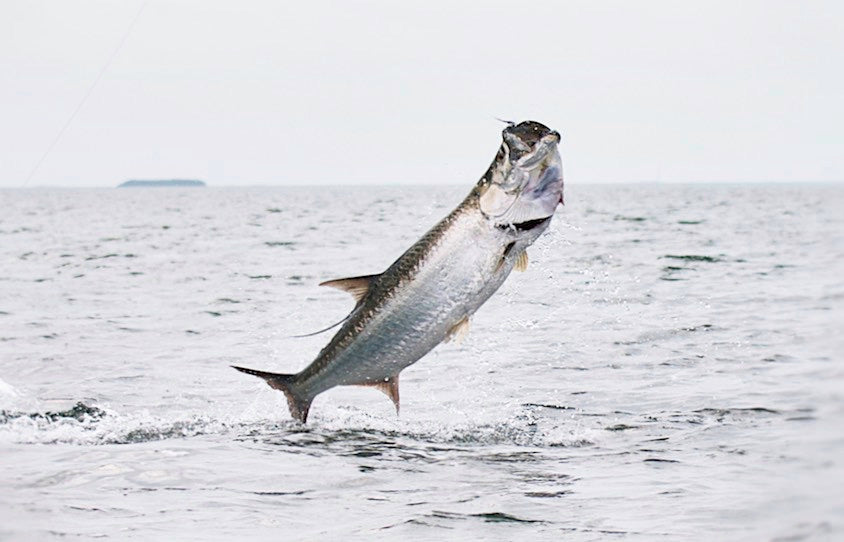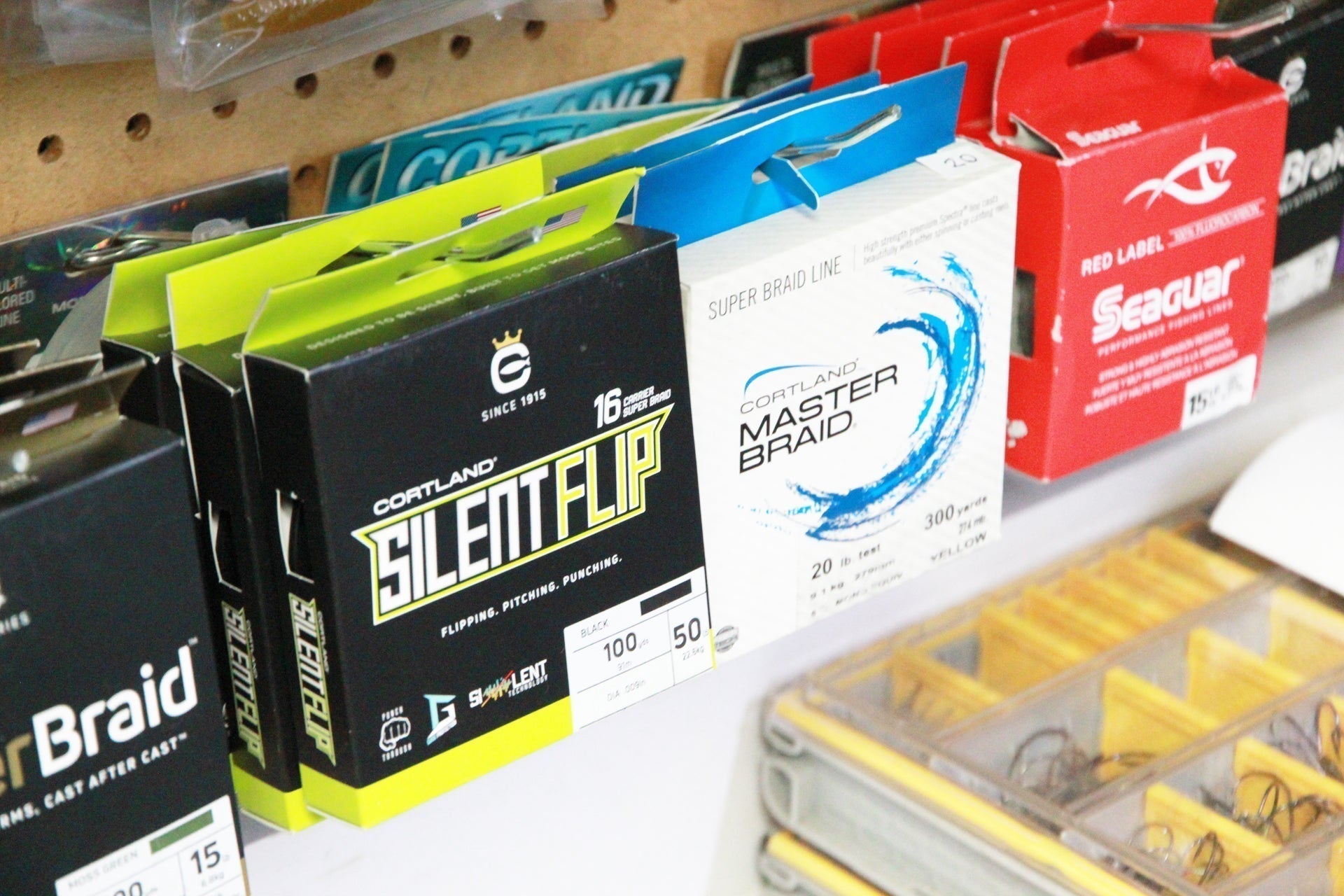Article Written by Paul Bruun & Frank Catino.
Article Read Time: 6 Minutes
The magic of chasing tarpon with fly tackle was popularized and continues to be refined in the transparent Florida Keys’ waters. Even the most experienced watermen continually thrill at the arrival of schools of these giant silver herring-like ancients as they endlessly parade over brilliant white sand banks. Regardless of your fishing experience, it’s stimulating to spot a tarpon resting, rolling, or swimming into casting range. Facing fish that measure as long as most people are tall is true intimidation.

To level the playing field, mental and physical preparation is necessary. From experiences of helping anglers accomplish hooking, fighting, and landing a tarpon with fly tackle, I first watch how the angler casts. Knowing that most fly rodders’ journey to saltwater begins with a trout background means using 4-to 6-weight rods, not 10-and 11’s.
Well before a tarpon adventure, I request eager sportsmen to build a more comfortable feeling with weightier tarpon gear. Because many 12-weights are pretty stiff I can round newer anglers’ casting into shape sooner with 10-or 11-weight tackle. Practice on any water or lawn with backcasting room. Casting motions are the same for most single-hand fly fishing applications, but larger rods must be moved faster and with more emphasis to achieve line speeds that load these thicker rod blanks. Tarpon gear shows casting weaknesses even faster than trout outfits reveal.
One competent client hauled his 12-weight Sage and Fin-Nor No. 3 tarpon reel to a windy nearby lake and spent hours casting for mackinaw (lake trout)! Typically, this is 7-or 8-weight business, but exercising with a heavier tackle in often gusty conditions worked him into excellent shape for Florida winter and spring tarpon trips.

A curable mental insecurity that arises during early efforts to perform with tarpon-sized tackle is making far too many false casts. Combat this common fish-blowing event by understanding the importance of only making an accurate 30- to 40-foot tarpon presentation. Yes, longer casts are better but your early success arrives by achieving the attainable.
Begin practice with a floating line, a 9-to-10-foot leader, and a hookless streamer or similar size yarn. Hold the fly in one hand and the rod—with 10 feet of line and the leader outside the rod tip—in the casting hand. For greater power firmly position the thumb on top and far forward on the rod grip. Pull and straighten 10 to 15 feet of extra casting/running line from the reel.
Always cast at a target (a bubble, a floating leaf) whenever practicing.

Forcefully roll the cast forward with the existing line you have, letting it rest momentarily on the surface. Once line, leader and fly straighten, make a strong backcast, pause momentarily, and firmly drive a forward cast that shoots at least 5 feet of running line. Don’t be in a hurry when first shaping this procedure.
Aim the cast above the surface target. Success is having the forward cast stop, so the line and leader straighten and settle gently into the water. Tarpon don’t tolerate a fat fly line crashing nearby!
When this casting routine is comfortable, determine to shoot another five or more feet of line on the forward cast. Practicing short, incremental line additions, especially when using new equipment, minimizes frustration. Casting tarpon-weight rods is tiring. Tired casters install mistakes.
Tarpon presentation competency is built by pacing yourself and avoiding frustration. Your false casting will diminish and greater distance will come. Think patience!

Tarpon are larger than probably any fish you’ve pursued, so their size disguises just how fast they swim. Landing your fly well ahead of a cruising tarpon is paramount to allow the fish to recognize it and not be spooked by the cast. It’s deceiving, however, to watch and try to lead the fish. Instead, target a spot well ahead of the moving tarpon or school and aim a cast to that location. Do the same to a resting (laid-up) tarpon. Focus on that casting spot, not the fish.
Another challenge is to remain composed once your fly is presented to an approaching or laid-up tarpon. Resist the habit of beginning to strip automatically before the fly can be seen. Rather, slowly bump the fly to judge the mood of the fish. Your guide’s experience of reading a tarpon’s behavior will coach your retrieve timing and when to set the hook with a firm strip strike or two or three!
IT’S A $20 FINE FOR MAKING A TROUT STRIKE!!!
Many details must come together to make your tarpon strike happen. Having been part of years of saltwater design and testing I know that when my fishermen are using Cortland’s Tropic Plus Tarpon floating lines they have the best chance of success. The 41-foot head is easy to begin casting and also perfectly balanced for lengthier shots. For the aquarium-clear oceanside Keys and Gulf conditions, Cortland’s latest Liquid Crystal Clear Tarpon Taper (same Tropic Plus taper) is a favorite. For not-so-clear and rougher water conditions, my boat carries Tropic Plus Ghost Tips (9-foot clear intermediate) on both right-hand and left-hand-wind tarpon reels to suit clients. Ghost Tips are always spooled when tarpon exploration involves a passport.
Your first visual tarpon fly grab is glorious!
Next.......IT’S CHAOS!

IMPORTANT!
Please FOCUS on carefully clearing all extra running lines. Tarpon will instantly perform this for you, but often in disastrous ways!!!
Keep line unnecessary for current casting distances on the reel. The less extra running line on the deck or in a casting basket reduces leader-popping train wrecks as a fish explodes after being hooked.
This is the most exciting 3 heartbeats in fly fishing and also when many fish are lost by beginners and experienced fly folks. Why? Excited anglers clamp on the fly line! It’s almost as bad when a sizzling outgoing running line suddenly half-hitches around the rod butt, reel handle, finger, wrist, zips under a foot, and various other insidious snags.
WARNING!!!
Heartbreaks are sudden with fly rod tarpon fishing break-offs. Broken rods, snapped leaders and even broken fly lines occur when these supercharged giants vault to the horizon. Some tarpon-ists choose to bolster fly leaders with heavier than “IGFA 15- and 20-pound class tippets,” only tapering down to 30-40-pound test that’s connected to a heavy bite/shock tippet with the fly. Such unforgiving leaders can lead to broken rods and worse accidents. Take care when pursuing this path.
Experienced fly anglers with balanced tackle utilizing extensive low-rod pressure land amazingly large tarpon in less time than fishermen using heavy spin/conventional gear. After the leaping and initial runs slow, straight pull pressure with minimal fly rod bend takes a dramatic toll on the tarpon. Even relaxing pressure for a moment and these superbly conditioned creatures will grab a second wind. Then it’s like the Snickers Bar ad says……When you’re gonna be awhile!!!
To learn more about modern fly rod tarpon fishing, examine the following material.
- Tarpon On Fly by Donald Larmouth, with Captain Rob Fordyce.
- Lords Of The Fly by Monte Burke
- A Passion For Tarpon by Andy Mill
- High Rollers by Bill Bishop
- Tarpon, The Movie (DVD) by Guy de la Valdene, Tom McGuane, Jimmy Buffet music.

About the Author
Paul Bruun has been writing outdoor columns and magazine articles for over 50 years in newspapers from South Florida to Jackson, Wyoming. He is a former Jackson Town Councilman, editor and co-publisher of the Jackson Hole Daily and currently bi-weekly Jackson Hole News&Guide Outdoors columnist. He co-founded the low profile, high performance South Fork Skiff fiberglass driftboat and guided and outfitted on rivers in northwestern Wyoming for 37 years.
Bruun is a Patagonia Fly Fishing Ambassador and pens the Classics column for Trout Unlimited’s TROUT Magazine. He and his wife Jean spend winter months in Ft. Pierce, FL and summers in Jackson where Jean guides for Wyoming Angling Company LLC.
Contact: PaulBruun@earthlink.net
Captain Frank Catino is a Brevard County, Florida, native and long time former Satellite Beach Town Councilman and Mayor whose over 45-year guiding career includes Mosquito Lagoon, Indian River and both inshore and offshore between there and the Bahamas. He pioneered The Catino, early, affordable machined bonefish and tarpon fly reels. He has worked with the Cortland Line Company for 24 years in sales and product development.
Frank Chairs the Citizens Advisory Committee for the National Estuary
Program for the Indian River. His tarpon quest includes guiding 25 plus Keys spring tarpon seasons. He regularly follows and coordinates Indian River tarpon migrations with Bonefish Tarpon Trust.
He’s an Orvis Endorsed Greater Orlando/Indian River fly rod guide.
Contact: Indian River Fishing Charters CaptFrankCatino.com 321 223-7700; fcatino1@me.com


